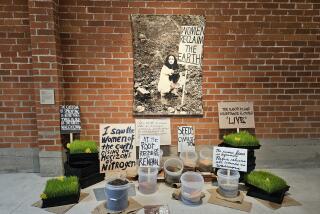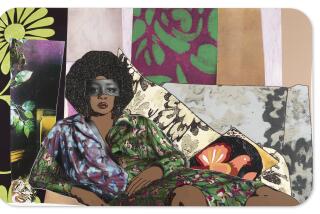Women Hope to Vault Into Museums With Title IX
- Share via
NEW YORK — Twenty-five years ago, a law called Title IX revolutionized college athletics, boosting women’s teams and paving the way for a 1990s boom in professional women’s sports.
Now a group of artists wants to use the same statute for the sake of art--to get more women’s work on the walls and display floors of some of New York City’s most prominent museums.
If it worked for dribblers, dunkers and long jumpers, they ask, why not for painters, sculptors and designers?
The athletes “so unequivocally succeeded in what they had set out to do, it inspired us,” artist Mary Beth Edelson said.
The Title IX Task Force, a loosely organized group of about 30 artists, says museums have ignored female artists, denying them the visibility and career boost that comes with inclusion in a major exhibit. The task force is staging exhibits of works by women artists at the Dorfman Projects gallery in Manhattan to draw attention to the cause, and says it plans legal action.
“It’s not malevolent discrimination so much as it is die-hard habit,” said artist Dena Shottenkirk. “But that needs to be jolted, I think sometimes in less-than-polite ways.”
Like universities, museums sponsor educational activities and receive federal funds, and therefore are covered by Title IX’s ban on sex discrimination, said Yolanda Wu, a lawyer at the NOW Legal Defense and Education Fund.
“It would clearly be a novel use of Title IX, but it would be intriguing,” Wu said. “It’s an underused statute.”
The issue of women’s representation at museums is not new. In the 1980s and early ‘90s, a group known as the Guerrilla Girls wore gorilla suits to museum and gallery openings and carried signs that accused the institutions of neglecting female artists.
Art collector Wilhelmina Cole Holladay, believing that most prominent museums did not display enough art by women, founded the National Museum of Women in the Arts in Washington in 1987. The museum’s collection is wide-ranging, including art dating back to the Renaissance.
Because museums prefer to display work by artists established over many years, major exhibitions often reflect biases that shaped the art world decades ago, said Robert Rindler, dean of the art school at Cooper Union for the Advancement of Science & Art.
“If we’re talking about people who were influential in the ‘50, ‘60s and ‘70s, women are grossly underrepresented,” he said. “Contemporary exhibits are very different. . . . Any exhibition of contemporary artists naturally includes a lot of women.”
Rindler said he has “never seen work excluded” because of an artist’s sex. “But I don’t feel that women are as recognized for the strength of their work as men have been traditionally,” he added.
Female athletes made Title IX famous in the 1970s, taking colleges and universities to court to force them to expand their women’s sports programs. When President Nixon signed the Higher Education Act, which includes Title IX, less than $100,000 was being spent nationwide on women’s athletic scholarships. Now that figure is $179 million. Female participation in high school and college sports has skyrocketed.
The Title IX Task Force includes established artists like Edelson and Dorothea Rockburne as well as younger women.
Edelson said the Museum of Modern Art, the Solomon R. Guggenheim Museum and the Whitney Museum of American Art set the tone for much of the art world.
“Collectors will go to the museums and see work and think, ‘This is the Good Housekeeping seal of approval’ . . . and they go to a dealer and they buy that work,” Edelson said. “If the museums don’t include women . . . then the dealers have a very difficult time selling women.”
The museums, meanwhile, argue that they do include women.
The Guggenheim has put on shows by artists Jenny Holzer and Rebecca Horn, and plans an exhibition of Helen Frankenthaler, said museum spokesman Scott Gutterman.
Mary Lou Strahlendorff, a MOMA spokeswoman, cited several recent exhibitions devoted exclusively to female artists--including Cindy Sherman, Hannah Hoch, Annette Messager, Louise Bourgeois and Helen Chadwick--and a group exhibition focusing on women’s art in the 1990s. She said MOMA acquired work by at least 33 women last year.
“Women have always been pivotal to the Museum of Modern Art,” Strahlendorff said. “Our founders were women, our president is a woman . . . three of our seven chief curators are women.”
The first Title IX exhibit, which ended Jan. 31, featured Shottenkirk’s glass-and-wood replica of a lighted castle turret atop a box full of fig leaves.
Among other items on display were a shockingly yellow canvas covered by a giant profile of Mickey Mouse; a jewelry box that invites viewers to peer into drawers labeled “Nouns,” “Verbs” and “Adjectives, Adverbs”; and a montage of women’s faces and tiny photos inside a frame of aging, black-bound books.
Organizers hope that the shows will demonstrate that women are producing innovative art worthy of more display in museums.
“There’s a mess of women artists that do things that make your eyes fall out of your head,” said Janet Henry, a Queens sculptor and Title IX Task Force member who had a piece in the first show. “There’s all this good work out there that’s not taken as seriously as the work by men.”
More to Read
The biggest entertainment stories
Get our big stories about Hollywood, film, television, music, arts, culture and more right in your inbox as soon as they publish.
You may occasionally receive promotional content from the Los Angeles Times.










